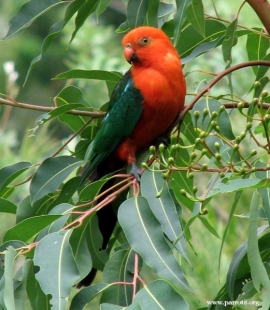Australian King Parrot |
|
|
Also known as: King Parrot, Eastern King Parrot, Queensland King Parrot, King Parakeet, King Lory, Red Lory, Scarlet and Green Parrot, Blood Rosella
Photos
View in GalleryDid You Know?
The Australian King Parrot acquires its adult plumage by a slow moult, which begins when the bird is over fifteen months old and is not completed for a further twelve months.Academic Research
Related publications: Alisterus scapularisSpecies Profile
Genus: Alisterus | Species: scapularis
Size:
43cm (16.8 in)
Weight:
195-275g (6.8 x 9.6 oz)
Subspecies including nominate:
two: A.s. scapularis, A.s. minor
Colour Adult:
A.s. scapularis: Male-red head, neck and underparts; hindneck has blue band; back and wings dark green; wing has silver/green band when folded; blue lower back and rump; tail black tinged with blue. Upper mandible orange/red with black tip, lower mandible black with orange base. Eye yellow. Female-green head and upperparts; red lower breast down to abdomen; silver/green on wing minimal or absent; dark green tail with pink at tip. Bill grey.
A.s. minor: Both adults as in scapularis, but smaller in size.
Colour Juvenile:
A.s. scapularis: As in adult female but lower breast green. Bill dull yellow.
Call:
Calls in flight are shrill and somewhat loud. When alarmed harsh and metallic shrieking. Males give high-pitched flute-like notes when perched.
Listen NowVideo Links:
Video 1 | Video 2More Information:
Content Sources:
CITES
BirdLife International
Cornell Lab of Ornithology/Birds of the World
Parrots: A Guide to Parrots of the World, Juniper and Parr, 1998
Animal Ageing and Longevity Database
ML Collection Catalogue 78592 Australian King Parrot (Alisterus scapularis), Robbins, Mark, New South Wales, Australia, Jun. 29, 1992, Cornell Lab of Ornithology. Site
Parrots of the World, Forshaw and Cooper, 1977. 2010 edition
Parrots of the World, Forshaw, 2006.
Parrots in Aviculture, Low, 1992.
Psittacine Aviculture, Schubot, Clubb and Clubb, 1992.
Parrots: Their Care and Breeding, Low, 1986.
Photos
View in GalleryDid You Know?
The Australian King Parrot acquires its adult plumage by a slow moult, which begins when the bird is over fifteen months old and is not completed for a further twelve months.Academic Research
Related publications: Alisterus scapularisSpecies Care
Captive Status:
Fairly common in Australia, less so elsewhere.
Longevity:
20-25 yrs
Housing:
Walk-in enclosure, minimum length 3m (9.8 ft).
Diet:
Small seed mix such as: canary, oats, safflower and a bit of hemp; spray millet; limited sunflower seed, dry, soaked or sprouted; sprouted or cooked beans and pulses; boiled maize; green leaves such as: Swiss chard, lettuce, sowthistle, dandelion, chickweed; vegetables such as: carrot, celery, zucchini, squash, green beans and peas in the pod; fruit such as: apple, pear, banana, cactus fruits, oranges; nuts such as: lightly cracked hazelnuts, pecans and roasted peanuts; complete pellet.
Enrichment:
Not recorded.
Nest Box Size:
Nest box or nesting log.
Clutch Size:
3-6
Incubation Time:
20 days
Fledging Age:
5 weeks
Hatch Weight:
10g (0.35 oz)
Peak Weight:
171-247g (6.0-8.6 oz)
Weaning Weight:
172-192g (6.0-6.7 oz)
Photos
View in GalleryDid You Know?
The Australian King Parrot acquires its adult plumage by a slow moult, which begins when the bird is over fifteen months old and is not completed for a further twelve months.Academic Research
Related publications: Alisterus scapularisSpecies Wild Status
World Population:
Unknown, decreasing.
IUCN Red List Status:
Least Concern
CITES Listing:
Appendix II
Threat Summary:
Population is affected by ongoing habitat loss; birds disappear from logged areas.
Range:
A.s. scapularis: SE coast and CE mainland Australia.
A.s. minor: NE Australia.
Habitat:
Occurs up to 1625m (5330 ft). Found in variety of habitats from high forested areas to lower more open spaces. During the breeding season birds are found in more dense forest such as wet sclerophyll forest, gullies, Eucalyptus woodland and savanna woodland bordering with riverine forest. Also, outside of breeding season they are found in cultivated lands, parks, orchards and sometimes gardens.
Wild Diet:
Eats fruits, flowers, berries, nuts, Eucalypt, Acacia and Angophora seeds, insect larvae, buds and other vegetation. A favourite is mistletoe Viscum album.
Ecology and Behaviour:
Are seasonally nomadic to a degree. Usually found in pairs or small groups, or post-breeding flocks of up to 50 individuals. Conspicuous when not feeding; when eating wary and quiet. Gather in groups to feed in morning, then sit quietly through the heat of the day, becoming active again in late afternoon.
Clutch and Egg Size:
3-6 rounded eggs, 33.0 x 27.0mm (1.3 x 1.0 in)
Breeding Season:
September-January; nesting is in a hollow limb or a deep cavity in large trees.
Related Links:
Photos
View in GalleryDid You Know?
The Australian King Parrot acquires its adult plumage by a slow moult, which begins when the bird is over fifteen months old and is not completed for a further twelve months.Academic Research
Related publications: Alisterus scapularisMembers Only Resources
Please log-in now to find more research, resources and tools.
Not a Member?
Find more great information:
Gain exclusive access to 600+ pages of additional research, seminars and podcasts, specialists to ask your toughest questions, and dozens of other fun resources - when you become a WPT member.
Join Today >>

































